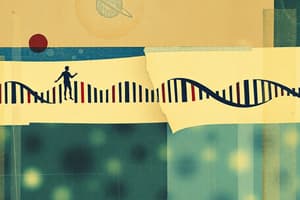Podcast
Questions and Answers
What is the primary role of transcription factors in the transcription process?
What is the primary role of transcription factors in the transcription process?
- To facilitate the termination of the transcription sequence.
- To directly synthesize RNA from the DNA template.
- To maintain the structural integrity of the DNA during transcription.
- To enhance or inhibit the binding of RNA polymerases to the promoter. (correct)
What is the function of RNA polymerases during the transcription process?
What is the function of RNA polymerases during the transcription process?
- To facilitate the assembly of ribosomes for protein synthesis.
- To unwind the DNA double helix without facilitating new RNA strand formation.
- To initiate the degradation of RNA polypeptides once transcription is complete.
- To synthesize RNA using the DNA strand as a template, performing elongation. (correct)
In eukaryotes, the formation of the initiation complex requires which additional factor compared to prokaryotes?
In eukaryotes, the formation of the initiation complex requires which additional factor compared to prokaryotes?
- General transcription factors (correct)
- Eukaryotic ribosomes
- DNA helicase
- Termination factors
During the termination phase of transcription, which mechanism is predominantly employed in prokaryotes?
During the termination phase of transcription, which mechanism is predominantly employed in prokaryotes?
What distinct structural feature of a gene is vital for the binding of RNA polymerases during transcription initiation?
What distinct structural feature of a gene is vital for the binding of RNA polymerases during transcription initiation?
Flashcards
RNA Polymerases
RNA Polymerases
Enzymes that synthesize RNA molecules from DNA templates.
Transcription Factors
Transcription Factors
Proteins that bind to specific DNA sequences and regulate gene expression.
Initiation Complex
Initiation Complex
Assembly of proteins necessary for RNA synthesis to begin.
Transcription Initiation
Transcription Initiation
Signup and view all the flashcards
Transcription Elongation
Transcription Elongation
Signup and view all the flashcards
Transcription Termination
Transcription Termination
Signup and view all the flashcards
Prokaryotic Transcription
Prokaryotic Transcription
Signup and view all the flashcards
Eukaryotic Transcription
Eukaryotic Transcription
Signup and view all the flashcards
Gene Structure
Gene Structure
Signup and view all the flashcards
Transcription Machinery
Transcription Machinery
Signup and view all the flashcards
Study Notes
Gene Fine Structure
- Genes have specific sequences that dictate protein production.
- RNA polymerases are enzymes that synthesize RNA from DNA templates.
- Transcription factors and machinery are proteins that regulate gene expression by binding to DNA and initiating transcription.
- Formation of the initiation complex is a critical step, bringing together all components necessary for transcription initiation.
- Transcription involves three main steps—initiation, elongation, and termination—which are different in prokaryotes and eukaryotes.
Prokaryotic Transcription
- Prokaryotic transcription occurs in a single compartment, the cytoplasm.
- Prokaryotic initiation is simpler, with the RNA polymerase binding directly to the promoter.
- Prokaryotic elongation proceeds continuously.
- Prokaryotic termination involves specific termination signals(e.g. hairpin loops) causing RNA polymerase to release the newly made RNA.
Eukaryotic Transcription
- Eukaryotic transcription happens in the nucleus.
- Eukaryotic initiation is more complex, with various transcription factors and a pre-initiation complex forming.
- Eukaryotic elongation happens while the growing RNA chain remains bound to DNA.
- Eukaryotic termination signals are complex, possibly including endonucleolytic cleavage.
Studying That Suits You
Use AI to generate personalized quizzes and flashcards to suit your learning preferences.




